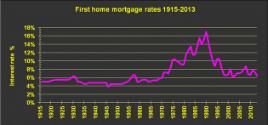Property buyers urged to build in buffer to avoid surge of Mortgagee in Possession sales
Published on 09 May, 2013
Property buyers coaxed into the market by record low interest rates should factor in a buffer in case the economy improves and rates are increased to slow the economy...
However, there's no expectation of a return to the ‘crazy' days of 17% borrowing rates at the end of the 1980s.
CQUniversity Property degree academic Ian Clarkson suggests factoring in a buffer ensuring repayments can be achieved at a borrowing rate of up to 8-9%.
His colleague Associate Professor Garrick Small notes that rates from Governor Phillip's time to 1970 were seldom above 6% and then only briefly.
"However 1970-1990 was a unique and crazy time when rates went ballistic. Recognising that the 1970-1990 years were the true aberrations is important. Rates then were unsupportable and existed only as a result of other social changes.
"I would say that we are returning to an economic environment where about 5.5% will be the highest robustly tolerable just like it was for most of our country's history."
Assoc Prof Small made these additional observations:
- At 2.75% our official rate is still considerably above many of our trading partners including the USA (0.13%), Britain (0.5%), the Euro area (0.5%) and Japan (0.1%). Being able to support a high interest rate regime may appear to be something to crow about in the current world financial climate, but it is a bit like being proud of how much rat poison you can swallow without falling off your perch.
- The fall in home mortgages, if the RBA rate drop is passed through to home owners, represents less than a 2.5% fall in repayments. On a $300,000 loan it will be about as much of a savings as a fall in petrol prices from $1.49 to $1.29. That is the kind of swings that happen almost weekly. The $10 per week saving will be welcome, but hardly life changing. What it will change is perceptions and perceptions mean more than hard realities when it comes to economic action.
- We have forgotten that 25 years ago interest rate changes of one or two percent hardly put a dent in economic enthusiasm. Today a rate change of 0.25% in interest rates causes hand wringing about what it will do the economy.
- Wayne Swan is trying to sell the rate drop as a win for his government. He doesn't seem to realise that rates drop because economies are weak. Hardly a commendation.
- Treasurer Swan is right however that common sense knows that living under crippling debt is bad for the community. Any interest rate cut represents a little breathing space, but the dependency on debt remains.
- Australians led the world in growing their personal debt in the decade from about 1992. We are now a world leader in personal indebtedness. We need low interest rates to survive.
- Being enslaved to debt as a nation is not a strong position. If rates move against us there will be no escape from their crippling effects. Our borrowing binge has left us vulnerable and that will not go away in a hurry.
- Living on rising debt allowed us to live beyond our means for at least a decade. Repaying that debt will mean living below our means until it is repaid and repaid with interest.
- Rising debt 1992-2005 was largely responsible for fuelling the property boom that has left our real estate markets largely overpriced. It now means that real estate is too expensive to allow people, either renting or servicing mortgages, to live comfortably. That is, it has undermined our standard of living.
- The answer is not simply to lower interest rates; it is to find the ways and the will to reduce our overall dependence on borrowed money to live.
- The reign of monetarism may be coming to a close and it is high time that Australia remembered that there are other ways to limit borrowing that include more dynamic direct lending limits and bank reserve limits.




